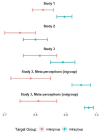People See Political Opponents as More Stupid Than Evil
- PMID: 35481435
- PMCID: PMC10302377
- DOI: 10.1177/01461672221089451
People See Political Opponents as More Stupid Than Evil
Abstract
Affective polarization is a rising threat to political discourse and democracy. Public figures have expressed that "conservatives think liberals are stupid, and liberals think conservatives are evil." However, four studies (N = 1,660)-including a representative sample-reveal evidence that both sides view political opponents as more unintelligent than immoral. Perceiving the other side as "more stupid than evil" occurs both in general judgments (Studies 1, 3, and 4) and regarding specific issues (Study 2). Study 4 also examines "meta-perceptions" of how Democrats and Republicans disparage one another, revealing that people correctly perceive that both Democrats and Republicans see each other as more unintelligent than immoral, although they exaggerate the extent of this negativity. These studies clarify the way everyday partisans view each other, an important step in designing effective interventions to reduce political animosity.
Keywords: affective polarization; meta-perceptions; political polarization; social perceptions.
Conflict of interest statement
The author(s) declared no potential conflicts of interest with respect to the research, authorship, and/or publication of this article.
Figures







References
-
- Ahler D. J. (2014). Self-fulfilling misperceptions of public polarization. The Journal of Politics, 76(3), 607–620. 10.1017/S0022381614000085 - DOI
-
- Berrien H. (2020, March12). Nurse who works at planned parenthood: I “work with a smile.” The Daily Wire. https://www.dailywire.com/news/nurse-who-works-at-planned-parenthood-i-w...
-
- Brandt M. J., Reyna C., Chambers J. R., Crawford J. T., Wetherell G. (2014). The ideological-conflict hypothesis: Intolerance among both liberals and conservatives. Current Directions in Psychological Science, 23(1), 27–34. 10.1177/0963721413510932 - DOI
-
- Brennan J. (2016, November10). Trump won because voters are ignorant, literally. Foreign Policy. https://foreignpolicy.com/2016/11/10/the-dance-of-the-dunces-trump-clint...
Publication types
MeSH terms
LinkOut - more resources
Full Text Sources

